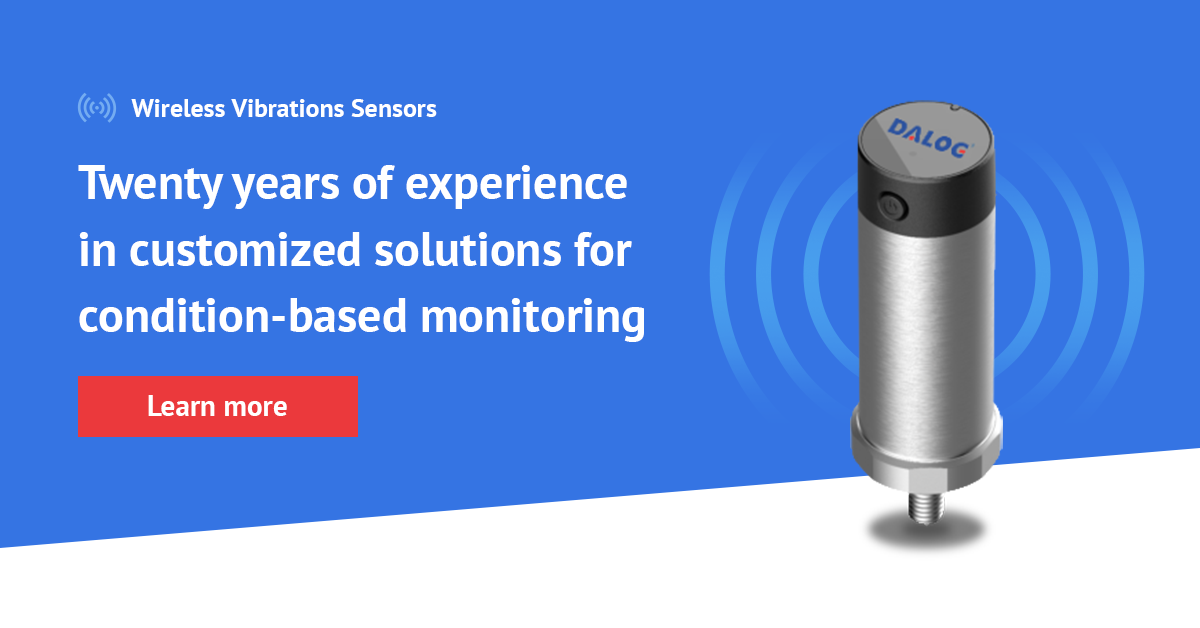How Do Vibration Sensors Work and Why Do You Need Them?
Vibration sensors measure the mechanical vibration and oscillation of industrial machinery and equipment. They play a critical role in industrial maintenance and asset management, as they help detect potential equipment failures and prevent costly downtime.
Condition monitoring involves tracking the performance of machinery and equipment to detect any early signs of potential problems or faults. This is achieved through the use of various sensors and data analysis techniques. On the other hand, predictive maintenance entails using data from condition monitoring to predict when maintenance should be performed before a failure occurs. This approach can help prevent equipment downtime and reduce maintenance costs.
The use of vibration sensors in condition monitoring and predictive maintenance has become increasingly popular in recent years due to their effectiveness and ease of implementation. By detecting the vibrations produced by equipment, vibration sensors can provide valuable insight into the condition of machinery and detect any potential faults before they lead to equipment failure. This can save companies significant amounts of money and improve the safety and reliability of their equipment. In the following sections, we'll delve into how vibration sensors work and their applications in industrial maintenance.
- What are vibration sensors?
- How do vibration sensors work?
- Applications of vibration sensors
- Choosing the suitable vibration sensor for your application
What Are Vibration Sensors?
Vibration sensors, also known as accelerometers, measure mechanical vibration and oscillation. They detect and monitor the movement and performance of machinery and equipment. Vibration sensors convert mechanical motion into an electrical signal that can be measured and analyzed.
The primary purpose of vibration sensors is to detect mechanical faults in industrial equipment. By measuring the vibrations produced by machinery, vibration sensors can provide insight into the condition of the equipment and detect any early signs of potential problems or failures. This information can then be used for condition monitoring and predictive maintenance, helping to prevent equipment downtime and reduce maintenance costs.
Several types of vibration sensors are available in the market, each with unique features and applications. Some of the most common types include:
Piezoelectric Accelerometers - They use a crystal or ceramic material that generates an electrical charge in response to mechanical stress.
Capacitive Accelerometers - These sensors measure acceleration by analyzing the change in capacitance between two plates.
Microelectromechanical Systems (MEMS) Accelerometers - MEMS accelerometers are smaller and less expensive than other types of vibration sensors. They are typically used for low-frequency applications.
Velocity Sensors - These sensors measure the velocity of vibration rather than acceleration. They are typically used for monitoring high-speed machinery.
Displacement Sensors - These sensors measure the distance a vibrating object moves from its equilibrium position. They are typically used for low-frequency applications.
Accelerometers - They measure vibration by detecting changes in acceleration caused by mechanical motion. Accelerometers can measure both high and low-frequency vibrations, making them ideal for a wide range of applications.
Proximity probes - Proximity probes measure the distance between the probe and the target object. They are typically used for high-speed rotating machinery and can measure vibrations at high frequencies.
Eddy current sensors - Eddy current sensors measure changes in magnetic fields caused by changes in vibration. They are commonly used for monitoring the health of bearings and gearboxes.
Laser Doppler vibrometers - Laser Doppler vibrometers measure vibration by detecting changes in laser light caused by mechanical motion. They are typically used for high-precision applications and can measure vibrations at high frequencies.
The choice of vibration sensor will depend on the specific application and requirements. Factors to consider include the frequency range of the vibrations being measured, the sensitivity of the sensor, and the environmental conditions in which it will be used.
Learn more about The Advantages of Wireless Sensors in Predictive Maintenance Programs
How Do Vibration Sensors Work?
Vibration sensors work by measuring the mechanical vibration and oscillation of machinery and equipment. They do this by converting the mechanical motion into an electrical signal that can be measured and analyzed. The working principle of vibration sensors can be broken down into three main steps:
Sensing: The sensing element is a part of the vibration sensor that directly measures the mechanical vibrations of the machine or structure. The most common type of sensing element is an accelerometer, which typically consists of a small mass attached to a spring or piezoelectric crystal. When the machine vibrates, the mass moves relative to the spring or crystal, generating a small electrical charge proportional to the vibration amplitude.
Signal Conditioning: The signal conditioner is responsible for amplifying and filtering the electrical signal generated by the sensing element to ensure that it can be accurately measured and analyzed. The signal conditioner typically includes filters to remove unwanted noise and interference and amplifiers to boost signal strength.
Data Acquisition: The data acquisition system is responsible for recording and analyzing the electrical signal generated by the vibration sensor. This system typically includes a data logger or computer interface that captures the signal from the sensor and analyzes it to detect abnormal vibration patterns.
The vibration sensor is typically mounted on or near the monitored machine or structure. The sensing element is oriented in the direction of the measured vibration. As the machine vibrates, the sensing element generates an electrical signal amplified and filtered by the signal conditioner, then recorded and analyzed by the data acquisition system.
By analyzing the vibration data over time, engineers can detect changes in vibration patterns that may indicate a potential mechanical fault or failure. This allows for early detection and proactive maintenance, which can help to prevent unexpected downtime and reduce maintenance costs.
Applications of Vibration Sensors
Vibration sensors have various industrial applications, particularly in machinery maintenance and condition monitoring. Some typical applications of vibration sensors include:
Machinery Vibration Monitoring: Vibration sensors are often used to monitor the vibration levels of industrial machinery, such as motors, pumps, and fans. By measuring the vibration levels over time, vibration sensors can detect changes in the equipment's condition, such as bearing wear, misalignment, or unbalance.
Bearing Condition Monitoring: Vibration sensors can be used to monitor the condition of bearings in rotating machinery. By analyzing the vibration levels of the bearings, vibration sensors can detect early signs of wear or damage, allowing for timely repairs or replacement.
Gearbox Vibration Monitoring: Gearboxes are critical components in many types of industrial machinery, and monitoring their vibration levels is essential for detecting potential problems. Vibration sensors can detect gear wear, lubrication problems, and gearbox misalignment.
The benefits of using vibration sensors in condition monitoring and predictive maintenance are numerous, including:
Increased Uptime: By detecting potential equipment problems early, vibration sensors can help prevent equipment breakdowns and unplanned downtime.
Reduced Maintenance Costs: By identifying issues early, vibration sensors can reduce the need for expensive repairs or equipment replacement. This can reduce overall maintenance costs and improve the equipment's lifespan.
Improved Safety: Detecting potential equipment problems early can help prevent accidents and improve workplace safety.
Better Decision Making: By providing accurate and reliable data on equipment conditions, vibration sensors can help maintenance teams make informed decisions about when to perform maintenance, repairs, or replacement.
Vibration sensors are valuable for condition monitoring and predictive maintenance in various industrial applications. By detecting potential equipment problems early, vibration sensors can help increase uptime, reduce maintenance costs, improve safety, and enable better decision-making.
Learn more about DAWi, our wireless vibration sensor, ideal to use in remote locations, reliable, cost-effective, and easy to install.
Choosing the Suitable Vibration Sensor for Your Application
Choosing a suitable vibration sensor for your application is essential for accurate and reliable data collection. Here are some factors to consider when selecting a vibration sensor:
Frequency Range: The frequency range of the vibration sensor should be suitable for the type of machinery being monitored. Different types of machinery generate vibrations at different frequencies, so choosing a sensor that can measure the relevant frequency range is essential.
Sensitivity: The sensitivity of the vibration sensor determines its ability to detect small changes in vibration. Higher sensitivity sensors can detect minor changes in vibration but may also be more susceptible to noise and interference.
Environmental Conditions: The operating environment of the machinery being monitored will also impact the choice of vibration sensor. For example, if the machinery operates in a corrosive or high-temperature environment, the sensor must withstand these conditions.
Mounting Options: The mounting options for the vibration sensor should also be considered. Some sensors may be designed for direct mounting on the equipment, while others may require a separate mounting bracket.
Compatibility: Choosing a vibration sensor compatible with your existing monitoring systems and software is essential. This will ensure that the data collected can be easily integrated with your current monitoring and maintenance systems.
Cost: The cost of the vibration sensor is also an important consideration. While higher-end sensors may offer greater accuracy and reliability, they may also be more expensive. Choosing a sensor that fits your budget while still meeting your requirements for accuracy and reliability is essential.
Vibration sensors are critical to condition monitoring and predictive maintenance programs in industrial settings. They are designed to detect and measure mechanical vibration, warning of potential equipment failures before they can cause downtime or safety hazards.
Implementing vibration sensors in your industrial maintenance program can bring significant benefits, such as increased uptime, reduced maintenance costs, and improved safety. These sensors can detect potential equipment failures early, prevent unexpected downtime, and plan maintenance activities more effectively.
By taking proactive steps to monitor and maintain your equipment, you can improve your operations' efficiency and reliability, ensuring your business's long-term success.
Do you need help choosing the most cost-effective solution for predictive maintenance? Download our free eBook and learn more from:
The Reliability Manager’s Plan








